Loon
The loons (North America) or divers (United Kingdom / Ireland) are a group of aquatic birds found in many parts of North America and northern Eurasia. All living species of loons are members of the genus Gavia, family Gaviidae and order Gaviiformes.
| Divers/Loons | |
|---|---|
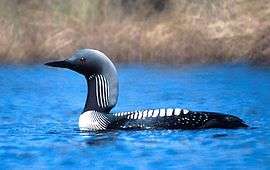 | |
| The Pacific loon (Gavia pacifica) is the sister species of the black-throated loon (G. arctica). | |
| Scientific classification | |
| Kingdom: | Animalia |
| Phylum: | Chordata |
| Class: | Aves |
| Order: | Gaviiformes |
| Family: | Gaviidae Coues, 1903[1] |
| Genus: | Gavia Forster, 1788 |
| Diversity | |
| 5 species | |
| Synonyms | |
|
Family-level: Genus-level: | |
Description
Loons, which are the size of a large duck or a small goose, resemble these birds in shape when swimming. Like ducks and geese, but unlike coots (which are Rallidae) and grebes (Podicipedidae), the loon's toes are connected by webbing. The loons may be confused with the cormorants (Phalacrocoracidae), but can be distinguished from them by their distinct call. Cormorants are not too distant relatives of loons, and like them are heavy-set birds whose bellies, unlike those of ducks and geese, are submerged when swimming. Loons in flight resemble plump geese with seagulls' wings that are relatively small in proportion to their bulky bodies. The bird points its head slightly upwards while swimming, but less so than cormorants. In flight, the head droops more than in similar aquatic birds.
 1918 illustration of a variety of loons by Archibald Thorburn. Top: Common loon, Mid-left: red-throated loon, Mid-right: yellow-billed loon, Bottom: black-throated loon
1918 illustration of a variety of loons by Archibald Thorburn. Top: Common loon, Mid-left: red-throated loon, Mid-right: yellow-billed loon, Bottom: black-throated loon.jpg) Common loon flying exhibiting the typical flight profile of a Gavia species
Common loon flying exhibiting the typical flight profile of a Gavia species Common loon (Gavia immer) rearing up. Note the plump body and pointed but rather short wings
Common loon (Gavia immer) rearing up. Note the plump body and pointed but rather short wings Yellow-billed loon (Gavia adamsii) in winter plumage
Yellow-billed loon (Gavia adamsii) in winter plumage
Male and female loons have identical plumage, which is largely patterned black-and-white in summer, with grey on the head and neck in some species. All have a white belly. This resembles many sea-ducks (Merginae) – notably the smaller goldeneyes (Bucephala) – but is distinct from most cormorants, which rarely have white feathers, and if so, usually as large rounded patches rather than delicate patterns. All species of loons have a spear-shaped bill.
Males are larger on average, but relative size is only apparent when the male and female are together. In winter, plumage is dark grey above, with some indistinct lighter mottling on the wings, and a white chin, throat and underside. The specific species can then be distinguished by certain features, such as the size and colour of the head, neck, back and bill. But reliable identification of loons in winter is often difficult even for experts – particularly as the smaller immature birds look similar to winter-plumage adults, making size an unreliable means of identification.[2]
Gaviiformes are among the few groups of birds in which the young moult into a second coat of down feathers after shedding the first one, rather than growing juvenile feathers with downy tips that wear off, as is typical in many birds. This trait is also found in tubenoses (Procellariiformes) and penguins (Sphenisciformes), both relatives of the loons.[3]
Behaviour and ecology
Loons are excellent swimmers, using their feet to propel themselves above and under water. However, since their feet are located far back on the body, loons have difficulty walking on land. Thus, loons avoid coming to land, except when nesting or severely injured. In 2020 a necropsy of a Bald Eagle found floating on a Maine lake (beside the floating body of a loon chick)found that the eagle had been stabbed through the heart by an adult loon's beak. [4]
Loons fly strongly, though they have high wing loading (mass to wing area ratio), which complicates takeoff. Indeed, most species must run upwind across the water's surface with wings flapping to generate sufficient lift to take flight.[5] Only the red-throated loon (G. stellata) can take off from land. Once airborne, loons are capable of long flights during migration. Scientists from the U.S. Geological Survey, who have implanted satellite transmitters in some individuals, have recorded daily flights of up to 1078 km in a 24-hour period, which probably resulted from single movements.[6] North European loons migrate primarily via the South Baltic and directly over land to the Black Sea or Mediterranean. Loons can live as long as 30 years and can hold their breath for as long as 90 seconds while underwater.[7][8]
Diet and feeding
Loons find their prey by sight. They eat mainly fish, supplemented with amphibians, crustaceans and similar mid-sized aquatic fauna. Specifically, they have been noted to feed on crayfish, frogs, snails, salamanders and leeches. They prefer clear lakes because they can more easily see their prey through the water. The loon uses its pointy bill to stab or grasp prey. They eat vertebrate prey headfirst to facilitate swallowing, and swallow all their prey whole.
To help digestion, loons swallow small pebbles from the bottoms of lakes. Similar to grit eaten by chickens, these gastroliths may assist the loon's gizzard in crushing the hard parts of the loon's food such as the exoskeletons of crustaceans and the bones of frogs and salamanders. The gastroliths may also be involved in stomach cleaning as an aid to regurgitation of indigestible food parts.
Loons may inadvertently ingest small lead pellets, released by anglers and hunters, that will contribute to lead poisoning and the loon's eventual death. Jurisdictions that have banned the use of lead shot and sinkers include but are not limited to Maine, New Hampshire, Vermont, some areas of Massachusetts, Yellowstone National Park, Great Britain, Canada, Michigan, and Denmark.[9]
Reproduction
Loons nest during the summer on freshwater lakes and/or large ponds. Smaller bodies of water (up to 0.5 km2) will usually only have one pair. Larger lakes may have more than one pair, with each pair occupying a bay or section of the lake. The red-throated loon, however, may nest colonially, several pairs close together, in small Arctic tarns and feed at sea or in larger lakes, ferrying the food in for the young.[7][8]
Loons mate on land, often on the future nest site, and build their nests close to the water, preferring sites that are completely surrounded by water such as islands or emergent vegetation. Loons use a variety of materials to build their nests including aquatic vegetation, pine needles, leaves, grass, moss and mud. Sometimes, nest material is almost lacking. Both male and female build the nest and incubate jointly for 28 days. If the eggs are lost, the pair may re-nest, usually in a different location. Since the nest is very close to the water, rising water may induce the birds to slowly move the nest upwards, over a meter.[7][8]
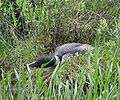 Common loon on the nest
Common loon on the nest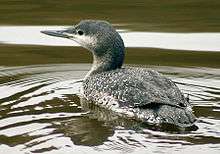 Juvenile red-throated loon
Juvenile red-throated loon Common loon feeding its young
Common loon feeding its young Immature common loon with crayfish
Immature common loon with crayfish
Despite the roughly equal participation of the sexes in nest building and incubation, analysis has shown clearly that males alone select the location of the nest. This pattern has the important consequence that male loons, but not females, establish significant site-familiarity with their territories that allows them to produce more chicks there over time. Sex-biased site-familiarity might explain, in part, why resident males fight so hard to defend their territories.[10]
Most clutches consist of two eggs, which are laid in May or June, depending upon latitude. Loon chicks are precocial, able to swim and dive right away, but will often ride on their parents' back during their first two weeks to rest, conserve heat, and avoid predators. Chicks are fed mainly by their parents for about six weeks but gradually begin to feed themselves over time. By 11 or 12 weeks, chicks gather almost all of their own food and have begun to fly.[7][8]
Biologists, especially from Chapman University, have extensively studied the mating behaviour of the common loon (G. immer). Contrary to popular belief, pairs seldom mate for life. Indeed, a typical adult loon is likely to have several mates during its lifetime because of territorial takeover. Each breeding pair must frequently defend its territory against "floaters" (territory-less adults) trying to evict at least one owner and seize the breeding site. Territories that have produced chicks in the past year are especially prone to takeovers, because nonbreeding loons use chicks as cues to indicate high-quality territories. One-third of all territorial evictions among males result in the death of the owner; in contrast, female loons usually survive. Birds that are displaced from a territory but survive usually try to re-mate and (re)claim a breeding territory later in life.[4][11][12][13]
A loon hatched for the first time in over a century in Southeastern Massachusetts at Fall River, the Massachusetts Division of Fisheries and Wildlife and Biodiversity Research Institute. The chicks were relocated in 2015 with the hopes of re-establishing breeding and nesting patterns.[14]
Etymology and taxonomy
The European Anglophone name "diver" comes from the bird's habit of catching fish by swimming calmly along the surface and then abruptly plunging into the water. The North American name "loon" likely comes from either the Old English word lumme, meaning lummox or awkward person, or the Scandinavian word lum meaning lame or clumsy. Either way, the name refers to the loon's poor ability to walk on land.[15]
Another possible derivation is from the Norwegian word lom for these birds, which comes from Old Norse lómr, possibly cognate with English "lament", referring to the characteristic plaintive sound of the loon.[16] The scientific name Gavia refers to seabirds in general.[17]
The scientific name Gavia was the Latin term for the smew (Mergellus albellus). This small sea-duck is quite unrelated to loons and just happens to be another black-and-white seabird which swims and dives for fish. It is not likely that the ancient Romans had much knowledge of loons, as these are limited to more northern latitudes and since the end of the last glacial period seem to have occurred only as rare winter migrants in the Mediterranean region.[18][19]
The term gavia was transferred from the ducks to the loons only in the 18th century. Earlier naturalists referred to the loons as mergus (the Latin term for diving seabirds of all sorts) or colymbus, which became the genus name used in the first modern scientific description of a Gavia species (by Carl Linnaeus) in 1758. Unfortunately, confusion about whether Linnaeus' "wastebin genus" Colymbus referred to loons or grebes abounded. North American ornithologists used the genus name to refer to grebes, while Europeans used it for loons, following Nicholas Aylward Vigors and Richard Bowdler Sharpe.
The International Commission on Zoological Nomenclature tried to settle this issue in 1956 by declaring Colymbus a suppressed name unfit for further use and establishing Gavia, created by Johann Reinhold Forster in 1788, as the valid genus name for the loons. However, the situation was not completely resolved even then, and the following year the ICZN had to act again to prevent Louis Jean Pierre Vieillot's 1818 almost-forgotten family name Urinatoridae from overruling the much younger Gaviidae. Some eminent ornithologists such as Pierce Brodkorb tried to keep the debate alive, but the ICZN's solution has been satisfactory.[19][20][21][22]
Systematics and evolution
All living species are placed in the genus Gavia. Phylogenetically, the five living species can be arranged as follows:[23]
| ||||||||||||||||||||||||||||||
| Cladogram of the extant Gavia species |
| Lineage | Image | Scientific name | Distribution |
|---|---|---|---|
| Basal lineage | _-_Summer_plumage_breeding_adult2.jpg) |
Red-throated loon or red-throated diver, Gavia stellata |
northern hemisphere |
| Black-throated lineage | .jpg) |
Black-throated loon, Arctic loon, or black-throated diver, Gavia arctica |
northern hemisphere, primarily breeding in freshwater lakes in northern Europe and Asia. |
 |
Pacific loon or Pacific diver, Gavia pacifica (formerly in G. arctica) |
northern Canada and eastern Siberia, and winters along the Pacific coast of North America | |
| Black-headed lineage |  |
Common loon, or great northern diver, Gavia immer |
coasts of the US as far south as Mexico, and on the Atlantic coast of Europe |
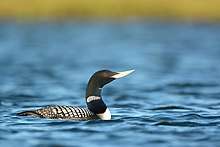 |
Yellow-billed loon or white-billed diver, Gavia adamsii |
Russia, Canada and the United States, Mexico and Spain. | |
Relationships
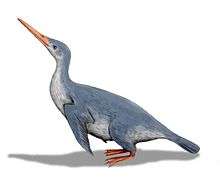
The loons were formerly often considered to be the most ancient of the northern hemisphere bird families; this idea grew basically out of the perceived similarity of shape and (probably) habits between loons and the entirely unrelated extinct Cretaceous order Hesperornithiformes. In particular Enaliornis, which was apparently an ancestral and plesiomorphic member of that order, was sometimes used to support claims of Albian (Early Cretaceous) Gaviiformes.[24][25]
More recently, it has become clear that the Anseriformes (waterfowl) and the Galliformes are the most ancient groups of modern birds. It is possible, though not at all well-supported, that these were distinct by the end of the Albian 100 million years ago (Ma). Loons belong to a more modern radiation. They were once believed to be related to grebes, which are also foot-propelled diving birds, and both species were once classified together under the order Colymbiformes. However, as long ago as the 1930s, it was determined that the two groups are not that closely related at all and are merely the product of convergent evolution and adapted in a similar way to a similar ecological niche. The similarity is so strong that even the most modern cladistic analyses of general anatomical features are easily misled into grouping loons and grebes.[24][26][27]
The Sibley-Ahlquist taxonomy still allied the loons with the grebes in its massively paraphyletic "Ciconiiformes", and it is almost certain that the relationships of loons lie with some of the orders placed therein. Namely, other recent authors have considered loons to share a rather close relationship with seabirds such as penguins (Sphenisciformes), tubenoses (Procellariiformes), waders (Charadriiformes) – and perhaps the newly discovered clade Mirandornithes which unites grebes (Podicipediformes) and their closest living relatives, the flamingos (Phoenicopteriformes). It is perhaps notable that some early penguins had skulls and beaks that were in many aspects similar to those of the living and fossil Gaviiformes.[26][28]
Fossil record
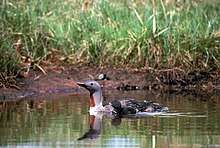
In prehistoric times, the loons had a more southerly distribution than today, and their fossils have been found in places such as California, Florida and Italy. The conflicting molecular data regarding their relationships is not much resolved by the fossil record; though they seem to have originated at the end of the Late Cretaceous like their presumed relatives, modern loons are only known with certainty since the Eocene. By that time almost all modern bird orders are at least strongly suspected to have existed – if not known from unequivocally identified specimens – anyway.[27]
Colymboides, the oldest unequivocal gaviiform genus known as of 2009, is widely known from early Priabonian – about 37 million years ago (Ma) in the Late Eocene – to Early Miocene (late Burdigalian, less than 20 Ma) limnic and marine rocks of western Eurasia north of the Alpide belt, between the Atlantic and the former Turgai Sea. It is usually placed in the Gaviidae already, but usually[29] in a subfamily Colymboidinae, with the modern-type loons making up the Gaviinae. But the Colymboides material is generally quite distinct from modern loons, and may actually belong in a now-extinct family of primitive gaviiforms.
Furthermore, the supposed genus could well be paraphyletic, so that for example Dyspetornis – which is now contained therein – might have to be separated again. A leg of an undescribed small loon was found in the Late Oligocene deposits at Enspel (Germany); it too may or may not belong to Colymboides. Of the crown genus Gavia, nearly ten prehistoric species have been named to date, and about as many undescribed ones await further study. The genus is known from the Early Miocene onwards, and the oldest members them are rather small (some are smaller than the red-throated loon). Throughout the late Neogene, the genus by and large follows Cope's Rule.[30][31]
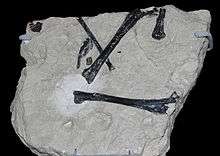
List of fossil Gavia
- Gavia sp. (Early-Middle Miocene of eastern United States)[32]
- Gavia egeriana Švec, 1982 (Early Miocene of Czechoslovakia ?and Cheswold, Delaware, United States –? Yorktown Early Pliocene of Lee Creek Mine, South Carolina, United States)[33]
- Gavia schultzi Mlíkovský, 1998 (Middle Miocene of Sankt Margarethen, Austria)[34]
- Gavia sp. (Calvert Middle Miocene ?or Pleistocene of Maryland, United States) – same as Gavia cf. immer below?[35]
- Gavia spp. (Middle Miocene of Steinheim, Germany) – three species[34]
- Gavia brodkorbi Howard, 1978 (Late Miocene of Orange County, United States)[36]
- Gavia moldavica Kessler, 1984 (Late Miocene of Chişinău, Moldova)[34]
- Gavia paradoxa Umanska, 1981 (Late Miocene of Čebotarevka, Ukraine)[34]
- Gavia concinna Wetmore, 1940 (Late Miocene/Early Pliocene of west and east United States)[37]
- Gavia fortis Olson & Rasmussen, 2001 (Yorktown Early Pliocene of Lee Creek Mine, South Carolina, United States)
- Gavia sp. (Early Pliocene of Empoli, Italy)[38]
- Gavia sp. (Early Pliocene of Kerč Peninsula, Ukraine)[34]
- Gavia palaeodytes Wetmore, 1943 (Bone Valley Early/Middle Pliocene of Pierce, Florida, United States)[39]
- Gavia howardae Brodkorb, 1953 (Yorktown Early Pliocene of Lee Creek Mine, South Carolina, United States – San Diego Middle[40] Pliocene of San Diego, California, United States)[41]
- Gavia cf. concinna (San Diego Middle/Late[40] Pliocene of San Diego, California, United States) – two species?[42]
- Gavia sp. (Early Pleistocene of Kairy, Ukraine)[34]
- Gavia cf. immer (Pleistocene of California and Florida, United States) – possibly a G. immer paleosubspecies[30]
"Gavia" portisi from the Late Pliocene of Orciano Pisano, Italy, is known from a cervical vertebra that may or may not have been from a loon. If so, it was from a bird slightly smaller than the common loon. Older authors were quite sure the bone was indeed from a Gavia and even considered G. concinna a possibly junior synonym of it. This is now regarded as rather unlikely due to the quite distinct range and age. The Early Pliocene Gavia skull from Empoli (Italy) was referred to G. concinna, and thus could conceivably have been of "G." portisi if that was indeed a loon. The holotype vertebra may now be lost, which would make "G." portisi a nomen dubium.[30][43]
In addition, there are some older fossils that are sometimes assigned to the Gaviiformes. From the Late Cretaceous, the genera Lonchodytes (Lance Formation, Wyoming, United States) and Neogaeornis (Quinriquina Formation, Chile) have been described; both are usually allied with orders which are considered related to loons. In particular the latter is still sometimes explicitly proposed as a primitive loon as they both were initially, but other authors consider Neogaeornis a hesperornithiform; note however that neither Gaviiformes nor Hesperornithiformes are known from the Southern Hemisphere or anywhere near it. Lonchodytes was more certainly quite close to loons, but probably closer still to some of the loons' relatives. Of similarly doubtful validity and surrounded by considerable dispute[44] is the supposed Late Cretaceous loon Polarornis (Seymour Island, Antarctica). Eupterornis from the Paleocene of Châlons-sur-Vesle (France) has some features reminiscent of loons, but others seem more similar to Charadriiformes such as gulls (Laridae).
A piece of a carpometacarpus supposedly from Oligocene rocks near Lusk, Wyoming, was described as Gaviella pusilla, but this handbone also shows some similarities to the plotopterids, flightless wing-propelled diving birds, and if these are apomorphic would make an unconvincing member of the Gaviidae (though it still could be a small-winged gaviiform in a yet-undescribed family "Gaviellidae"[45]): while the carpometacarpus in Gavia is somewhat convergent to that of wing-propelled diving birds, enabling the wings to be used as rudders for quick underwater turns, Colymboides still had an unspecialized plesiomorphic hand. Parascaniornis, sometimes allied to the loons by early authors, was eventually determined to be a junior synonym of the hesperornithiform Baptornis. A supposed mid-Eocene loon fossil form Geiseltal (Germany) was erroneously assigned to Gavia.[46]
In popular culture
- Various Indigenous myths from the California region have a recurring figure, Loon or Loon Woman, based on the common loon.[47]
- The common loon is the provincial bird of Ontario and is depicted on the Canadian one-dollar coin, which has come to be known affectionately as the "loonie".[48]
- The common loon is the official state bird of Minnesota.[49]
- Mercer, Wisconsin, promotes itself as the "Loon Capital of the World".[50]
- Henry David Thoreau describes a playful and inspiring acquaintance with a loon on Walden Pond in his book Walden.[51]
- The Great Lakes Loons are a minor-league professional baseball team based in Midland, Michigan, United States. The primary mascot is Lou E. Loon.[52]
- The Warner Bros. cartoon Tiny Toon Adventures features Shirley the Loon, who speaks with a thick Valley girl accent and is obsessed with superficial New Age paraphernalia. She is voiced by Saturday Night Live cast member Gail Matthius.[53]
- The Major League Soccer club Minnesota United FC use a loon in the club's crest, as well as a nickname for the team.[54]
- Canadian Loons are the bird noises in the song "Pacific State" by the band 808 State.[55]
Notes and references
- Melville, RV; Smith, JDD, eds. (1987). Official Lists and Indexes of Names and Works in Zoology. ICZN. p. 17.
- Appleby, R.H.; Steve C. Madge; Mullarney, Killian (1986). "Identification of divers in immature and winter plumages". British Birds. 79 (8): 365–91.
- Olson (1985: p. 212)
- Piper, W.H.; Walcott, C.; Mager, J.N. & Spilker, F. (2008b). "Fatal Battles in Common Loons: A Preliminary Analysis". Animal Behaviour. 75 (3): 1109–15. doi:10.1016/j.anbehav.2007.10.025.
- Evers, David C., James D. Paruk, Judith W. Mcintyre and Jack F. Barr. 2010. Common Loon (Gavia immer), The Birds of North America Online (A. Poole, Ed.). Ithaca: Cornell Lab of Ornithology; Retrieved from the Birds of North America Online: http://bna.birds.cornell.edu/bna/species/313
- "Common Loon Migration Study - Frequently Asked Questions". Umesc.usgs.gov. Retrieved 20 January 2018.
- Sjölander, S. & Ågren, G. (1972). "The reproductive behaviour of the Common Loon". Wilson Bull. 84 (3): 296–308. JSTOR 4160227.
- Sjölander, S. & Ågren, G. (1976). "The reproductive Behavior of the Yellow-billed Loon, Gavia adamsii (with G. Ågren)". The Condor. 78 (4): 454–63. doi:10.2307/1367094. JSTOR 1367094.
- For a review of the impact of lead shot and alternatives, see Minnesota Pollution Control Agency (2007): "Let's Get the Lead Out! Non-lead alternatives for fishing tackle"
For a review of gastrolith function, see Wings, Oliver (2007). "A review of gastrolith function with implications for fossil vertebrates and a revised classification" (PDF). Acta Palaeontologica Polonica. 52: 1–16. Archived from the original on March 7, 2008.CS1 maint: unfit url (link) - Piper, W.H.; Walcott, C.; Mager, J.N. & Spilker, F. (2008). "Nestsite selection by male loons leads to sex-biased site familiarity". Journal of Animal Ecology. 77 (2): 205–10. doi:10.1111/j.1365-2656.2007.01334.x. PMID 17976165.
- Piper, W.H.; Evers, D.C.; Meyer, M.W.; Tischler, K.B. & Klich, M. (2000): Do common loons mate for life?: scientific investigation of a widespread myth. In: McIntyre, J. & Evers, D.C. (eds.): Loons: old history and new findings – proceedings of a symposium from the 1997 meeting of the American Ornithologists' Union: 43–49. North American Loon Fund, Meredith, New Hampshire.
- Piper, W.H.; Tischler, K.B. & Klich, M. (2000). "Territory acquisition in loons: The importance of take-over". Animal Behaviour. 59 (2): 385–94. doi:10.1006/anbe.1999.1295. PMID 10675261.
- Piper, W.H.; Walcott, C.; Mager, J.N.; Perala, M.; Tischler, K.B.; Harrington, Erin; Turcotte, A.J.; Schwabenlander M. & Banfield, N. (2006). "Prospecting in a Solitary Breeder: Chick Production Elicits Territorial Intrusions in Common Loons". Behavioral Ecology. 17 (6): 881–888. doi:10.1093/beheco/arl021.
- "Loon hatches for 1st time in century in southeastern region". AP NEWS. 2020-07-10. Retrieved 2020-07-10.
- Mobley, Jason A. (2008). Birds of the World. Marshall Cavendish. p. 382. ISBN 9780761477754.
- Harper, Douglas. "loon". Online Etymology Dictionary. Retrieved 2015-09-04.
- LoonWatch – Loon FAQs|Northland College Archived 2010-08-13 at the Wayback Machine
- Brodkorb (1963: pp. 223–24)
- Arnott, W.G. (1964). "Notes on Gavia and Mergvs in Latin Authors". Classical Quarterly. New Series. 14 (2): 249–62. doi:10.1017/S0009838800023806. JSTOR 637729.
- Linnaeus, Carl (1758): 68.1. Colymbus arcticus. In: Systema naturae per regna tria naturae, secundum classes, ordines, genera, species, cum characteribus, differentiis, synonymis, locis (10th ed., vol. 1): 190 [Latin book]. Lars Salvius, Stockholm ("Holmius"). Digitized version
- International Commission on Zoological Nomenclature (ICZN) (1957–58). "The family-group names "Gaviidae" Coues, 1903 and "Urinatoridae" (correction of "Urinatores)" Vieillot, 1818 (Class Aves) – "Opinion" 401 and "Direction" 75". Bulletin of Zoological Nomenclature. 15A: 147–48.
- Brodkorb (1963: p. 223)
- Boertmann, D. (1990). "Phylogeny of the divers, family Gaviidae (Aves)". Steenstrupia. 16: 21–36.
- Stolpe, M. (1935). "Colymbus, Hesperornis, Podiceps:, ein Vergleich ihrer hinteren Extremität". J. Ornithol. (in German). 80 (1): 115–128. doi:10.1007/BF01908745.
- Brodkorb (1963: pp. 220–21)
- Slack, K.E.; Jones, C.M.; Ando, T.; Harrison G.L.; Fordyce R.E.; Arnason, U. & Penny, D. (2006). "Early Penguin Fossils, plus Mitochondrial Genomes, Calibrate Avian Evolution". Mol. Biol. Evol. 23 (6): 1144–55. doi:10.1093/molbev/msj124. PMID 16533822. Supplementary Material Archived 2009-12-16 at the Wayback Machine
- Mayr (2009)
- Olson (1985: pp. 212–13), Mayr (2004, 2009)
- Some (notably Robert W. Storer) have disagreed, usually because they separated Gaviella in the basalmost subfamily of the Gaviidae and considered Colymboides the ancestor of Gavia. More recent authors generally disagree at least regarding the latter: Storer (1956), Olson (1985), Mayr (2009: pp. 75–76)
- Brodkorb (1953)
- Brodkorb (1963: pp. 223–25), Olson (1985: pp. 212–13), Mlíkovský (2002: pp. 63–64), Mayr (2009: pp. 75–76)
- A tiny loon, smaller and more delicate than even the sympatric contemporary G. egeriana-like birds. Probably a distinct species – sexual dimorphism in loons is not very pronounced: Rasmussen (1998).
- A small loon, smaller than G. howardae: Olson (1985: pp. 213–214), Rasmussen (1998), Mlíkovský (2002: p. 63)
- Mlíkovský (2002: p. 64)
- USNM 16612, distal right tibiotarsus. Smaller than common loon; the polished-bone look and large size of the specimen makes a Miocene origin rather unlikely: Wetmore (1941), Olson (1985: p. 214).
- Known from a complete ulna. Slightly larger than G. egeriana, but smaller than G. howardae: Olson (1985: p. 214)
- Known from skull and limb bones. Much like a large Pacific loon but stouter and heavy-billed like common loon, and generally possessing apparently plesiomorphic traits that those two species share with the red-throated loon. Has been considered a possible junior synonym of "G." portisi, but this is nowadays considered unlikely: Brodkorb (1953), Mlíkovský (2002: p. 64), and see also at "Gavia" portisi.
- Known from a skull very similar to the black-throated loon. Initially assigned to G. concinna, but this is not very likely: Mlíkovský (2002: p. 64), and see also at "Gavia" portisi.
- Known from a few limb bones. Roughly similar in size to Pacific loon, but proportions seem to differ and apparently not close to any living species except maybe red-throated loon: Brodkorb (1953).
- BRODKORB, PIERCE (July 1953). "A REVIEW OF THE PLIOCENE LOONS" (PDF). Searchable Ornothological Research Archive.
- Maybe closest to Pacific loon but smaller than red-throated loon; might be quite distinct. A supposed record from Florida is probably in error: Brodkorb (1953, 1963: p. 224).
- Initially in part (specimens LACM 2110, 2142) assigned to G. concinna, but apparently one or two undescribed smaller species, about the size of the Pacific loon: Brodkorb (1953), Mlíkovský (2002: p. 64).
- Brodkorb (1963: p. 224), Mlíkovský (2002: pp. 64, 256–57)
- See for example the discussions in Mayr (2004, 2009).
- Not to be used without quotation marks, as it is not a valid taxon.
- Brodkorb (1963: pp. 220–23), Olson (1985), Mlíkovský (2002: pp. 64259–61), Mayr (2009: p. 20)
- Demetracopoulou, D. (1933). "The Loon Woman Myth: A Study in Synthesis". The Journal of American Folklore. 46 (180): 101–128. doi:10.2307/535774. JSTOR 535774.
- Stewart, Barry D. (2004): Across The Land: A Canadian Journey Of Discovery. Trafford Publishing. ISBN 1-4120-2276-2, p. 143
- Heinrichs, Ann (2003): Minnesota. Compass Point Books. ISBN 0-7565-0315-9, p. 44
- Moran, Mark; Sceurman, Mark; Godfrey, Linda S. & Hendricks, Richard D. (2005): Weird Wisconsin: Your Travel Guide to Wisconsin's Local Legends and Best Kept Secrets. Sterling Publishing. ISBN 0-7607-5944-8, p. 78
- chapter "Brute Neighbors"
- Gonzalez, John (August 11, 2013). "Experience Michigan: The Great Lakes Loons fans go bonkers for mascots Rall E. Camel and Lou E. Loon!". Booth Newspapers. Retrieved August 1, 2017.
- Tiny Toon Adventures (TV Series 1990â€"1995), retrieved 2019-01-29
- La Vaque, David (October 27, 2016). "Minnesota United to donate portion of 2017 season ticket purchases to help loons". Star-Tribune. Minneapolis. Retrieved August 1, 2017.
- "Classic Tracks: 808 State 'Pacific State'". Soundonsound.com. Retrieved 20 January 2018.
Bibliography
- Brodkorb, Pierce (1953). "A Review of the Pliocene Loons" (PDF). Condor. 55 (4): 211–14. doi:10.2307/1364769. JSTOR 1364769.
- Brodkorb, Pierce (1963). "Catalogue of fossil birds. Part 1 (Archaeopterygiformes through Ardeiformes)". Bulletin of the Florida State Museum, Biological Sciences. 7 (4): 179–293.
- Mayr, Gerald (2004). "A partial skeleton of a new fossil loon (Aves, Gaviiformes) from the early Oligocene of Germany with preserved stomach content" (PDF). J. Ornithol. 145 (4): 281–86. doi:10.1007/s10336-004-0050-9. Archived from the original (PDF) on 2015-09-24. Retrieved 2006-09-20.
- Mayr, Gerald (2009). Paleogene Fossil Birds. Heidelberg/New York: Springer-Verlag. ISBN 978-3-540-89627-2.
- Mlíkovský, Jirí (2002). Cenozoic Birds of the World, Part 1: Europe (PDF). Prague: Ninox Press.
- Montana Fish, Wildlife & Parks (Montana FW&P) (2007): Animal Field Guide: Common Loon; retrieved 2007-05-12.
- Olson, Storrs L. (1985). "Section X.I. Gaviiformes" (PDF). In Farner, D.S.; King, J.R.; Parkes, Kenneth C. (eds.). Avian Biology. 8. pp. 212–14.
- Rasmussen, Pamela C. (1998). "Early Miocene Avifauna from the Pollack Farm Site, Delaware" (PDF). Delaware Geological Survey Special Publication. 21: 149–51.
- Storer, Robert W. (1956). "The Fossil Loon, Colymboides minutus" (PDF). Condor. 58 (6): 413–426. doi:10.2307/1365096. JSTOR 1365096.
- Wetmore, Alexander (1941). "An Unknown Loon from the Miocene Fossil Beds of Maryland" (PDF). Auk. 58 (4): 567. doi:10.2307/4078641. JSTOR 4078641.
- United States Fish and Wildlife Service (USFWS) (2005): Common Loons at Seney NWR (June 2005), fws.gov; accessed July 6, 2017.
Recordings
- Voices of the Loon, Robert J. Lurtsema, narrator. recorded by William E. Barklow. North American Loon Fund/National Audubon Society. (1980)
External links
| Look up loon in Wiktionary, the free dictionary. |
| Wikimedia Commons has media related to Gavia. |
| Wikispecies has information related to Gaviidae |
- Tree of Life Gaviidae
- Loon sounds
- Loon videos on the Internet Bird Collection
- The Loon Project website
- Loon Preservation Committee
- Diving Birds of North America, by Paul Johnsgard
- Loon Dreaming - an animated short from the National Film Board of Canada